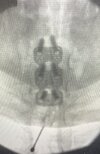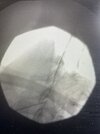LolSo do it in 60 sec with a 25
You are using an out of date browser. It may not display this or other websites correctly.
You should upgrade or use an alternative browser.
You should upgrade or use an alternative browser.
Selective Nerve Root Block and blood thinners
- Thread starter gdub25
- Start date
- Joined
- Oct 23, 2005
- Messages
- 8,279
- Reaction score
- 6,025
- Joined
- Jul 26, 2010
- Messages
- 2,575
- Reaction score
- 292
You know what's interesting.Yep.
I do, and yes, the 25g via interlaminar approach is barely felt, but I use local bc I tell the pt I’m numbing them up when I advance the needle.
When I use touhy needles patients never have felt a thing or rarely when I get into the epidural space.
With cutting needles like quinke, its painless until i pas through Lig Flavun. I shoot the dye and they do feel it..
- Joined
- Jun 16, 2021
- Messages
- 3,862
- Reaction score
- 4,235
Enter more parallel to the skin. Skinnier needle means higher velocity of medication coming out of the needle.You know what's interesting.
When I use touhy needles patients never have felt a thing or rarely when I get into the epidural space.
With cutting needles like quinke, its painless until i pas through Lig Flavun. I shoot the dye and they do feel it..
It’s the opposite for me, and the needle thing????
- Joined
- Jan 15, 2019
- Messages
- 757
- Reaction score
- 690
This morning I had an obese pt for a LESI…staff couldn’t find a six inch tuohy. I started to get excited to try the Steve approach with a spinal needle. But then staff found a six. Oh wells.
Is anybody aware of any published description of the Steve method?
Is anybody aware of any published description of the Steve method?
This morning I had an obese pt for a LESI…staff couldn’t find a six inch tuohy. I started to get excited to try the Steve approach with a spinal needle. But then staff found a six. Oh wells.
Is anybody aware of any published description of the Steve method?

Contrast Spread Technique: Evolution - PMC
Yakov Perper is the only one to have published on this so far, i *think*
- Joined
- Jan 15, 2019
- Messages
- 757
- Reaction score
- 690

Contrast Spread Technique: Evolution - PMC
pmc.ncbi.nlm.nih.gov
Yakov Perper is the only one to have published on this so far, i *think*
Thank you, will check these out.
- Joined
- Dec 13, 2005
- Messages
- 6,781
- Reaction score
- 5,477
So I do a mix up of all of the techniques fairly frequently. 20g Tuohy, touch down on lamina, rotate to CLO, tiny bit of contrast to confirm where I am, advance needle in CLO, looking for hanging drop, CLO, LOR, radiographic suspicion, all simultaneously. Typically, I will notice hanging drop about a half a mm before I get lor.
- Joined
- Apr 13, 2016
- Messages
- 3,475
- Reaction score
- 3,589
Same for me but 22g Tuohy. Not exactly hanging drop but the little bubble in the hub that drops in when you pop through ligament.So I do a mix up of all of the techniques fairly frequently. 20g Tuohy, touch down on lamina, rotate to CLO, tiny bit of contrast to confirm where I am, advance needle in CLO, looking for hanging drop, CLO, LOR, radiographic suspicion, all simultaneously. Typically, I will notice hanging drop about a half a mm before I get lor.
- Joined
- Jan 15, 2019
- Messages
- 757
- Reaction score
- 690
Figured I'd chime in with the highest level of evidence: a single anecdotal data point.
Readers digest version: A few weeks ago I did an ILESI on a patient who denied being on a thinner.
Well, it turns out he was actually on eliquis (though how consistently he takes it remains unclear).
On follow up he says he's doing great and using his Peleton apparently without a clinically significant epidural hematoma.
FWIW, I happened to have done this one with Lobel's 25g spinal technique.
Readers digest version: A few weeks ago I did an ILESI on a patient who denied being on a thinner.
Well, it turns out he was actually on eliquis (though how consistently he takes it remains unclear).
On follow up he says he's doing great and using his Peleton apparently without a clinically significant epidural hematoma.
FWIW, I happened to have done this one with Lobel's 25g spinal technique.
I use 23g, smaller than 22g but more maneuverable than 25gSo I know many of you are using a 25g, but are some of you using a 22g for these TFESI's while maintaining AC?
In addition, has almost everyone stopped holding blood thinners for cervical/thoracic mbbs/rfa as well, despite needle size? I used 18g.
Thanks in advance. You guys always help push me forward
- Joined
- Oct 23, 2005
- Messages
- 8,279
- Reaction score
- 6,025
Agree with others that 23G quincke is the king of pain needles. I use it for everything I can.
thoracic and lumber TFESI, caudals, lumbar MBB, SIJ, coccyx, hip etc.
thoracic and lumber TFESI, caudals, lumbar MBB, SIJ, coccyx, hip etc.
Last edited:
mygalperin
Full Member
- Joined
- Mar 4, 2025
- Messages
- 79
- Reaction score
- 9
Do not do it, it is probably safe, but if anything goes wrong they will eat you alive!Curious if anyone has a reference for anticoagulation guidelines for SNRB. My partner and I are having a discussion about if these are seen the same as TFESI from a legal perspective when it comes to blood thinners and risk. ASRA does not list SNRB as an injection type on their guidelines app.
Also, if I'm not mistaken, SIS guidelines say it's ok for TFESI on blood thinner, yeah?
- Joined
- Jun 16, 2021
- Messages
- 3,862
- Reaction score
- 4,235
You’re more likely to cause a CVA or an MI than a significant bleeding event. Saying it a different way, you are more likely going to kill your pt if you stop their AC, especially if it is Coumadin.Do not do it, it is probably safe, but if anything goes wrong they will eat you alive!
- Joined
- Aug 8, 2011
- Messages
- 4,260
- Reaction score
- 2,554
is it because of a beaurocracy thing?Haven’t stopped them in years for most things. Unfortunately I have a feeling at my new gig (hopd) I will be stopping them for everything
What state?
More like deep pockets rule. I don’t know for sure yet, but I get the feeling that for something where there is no official printed guideline on AC for spinal procedures they are likely to be very cautions and therefore require stopping for all neuroaxial procedures.is it because of a beaurocracy thing?
What state?
- Joined
- Feb 1, 2005
- Messages
- 5,874
- Reaction score
- 2,916
Yep. Deeper pockets, bigger target on the back. Very familiar.More like deep pockets rule. I don’t know for sure yet, but I get the feeling that for something where there is no official printed guideline on AC for spinal procedures they are likely to be very cautions and therefore require stopping for all neuroaxial procedures.
- Joined
- Dec 13, 2005
- Messages
- 6,781
- Reaction score
- 5,477
Probably will just be physicians discretion.
- Joined
- Oct 23, 2005
- Messages
- 8,279
- Reaction score
- 6,025
Including S1? Definitely more bleeding there.
resurrecting this thread. I'd still like to hear peoples thoughts on the risks of holding blood thinners with an S1 TFESI vs all other lumbar TFESI?Haven’t held blood thinners for tfesi in years
I agree it makes no sense to hold thinners for L1-L5 TFESI, but S1 is much more vascular with more bleeding, and I would think more likely to get a epidural hematoma doing S1 TFESI on thinners vs L1-L5 TFESI on thinners?
Thoughts?
Agree with the vascularity at S1 compared to other levels..still haven’t been holding. Although maybe I should start.resurrecting this thread. I'd still like to hear peoples thoughts on the risks of holding blood thinners with an S1 TFESI vs all other lumbar TFESI?
I agree it makes no sense to hold thinners for L1-L5 TFESI, but S1 is much more vascular with more bleeding, and I would think more likely to get a epidural hematoma doing S1 TFESI on thinners vs L1-L5 TFESI on thinners?
Thoughts?
You have been a proponent of using particulate steroid at this level, as have I been. Would you be also be concerned about that given the vascular issue there?
- Joined
- Oct 7, 2011
- Messages
- 16,802
- Reaction score
- 7,283
having had significantly more incidence of heme with S1 TF over all other TFESI, i hold anticoagulation for S1 TFESI or go L5 instead, when appropriate.
- Joined
- Oct 23, 2005
- Messages
- 8,279
- Reaction score
- 6,025
S1 is more vascular, but typically venous. Unless transitional anatomy, I continue to use depo at S1.Agree with the vascularity at S1 compared to other levels..still haven’t been holding. Although maybe I should start.
You have been a proponent of using particulate steroid at this level, as have I been. Would you be also be concerned about that given the vascular issue there?
The reason I brought it up is that yes I have often offered S1 TFESI with depo.
In patient on anticoagulation, I start with L5 TFESI and dex and don't hold thinners. Frequently due to dex, the patient gets relief for less than a month and so I then do bilateral S1 TFESI with depo, while holding thinners and then the patient gets 6 months of relief. But I'm now more "justified" to hold thinners for S1
Basically, I'm debating to just blend the two. If a patient is on thinners and its something that I think would better respond to S1 TFESI with depo, I'm debating to just go straight to S1 TFESI with depo and not hold the thinners.
That’s what I doS1 is more vascular, but typically venous. Unless transitional anatomy, I continue to use depo at S1.
The reason I brought it up is that yes I have often offered S1 TFESI with depo.
In patient on anticoagulation, I start with L5 TFESI and dex and don't hold thinners. Frequently due to dex, the patient gets relief for less than a month and so I then do bilateral S1 TFESI with depo, while holding thinners and then the patient gets 6 months of relief. But I'm now more "justified" to hold thinners for S1
Basically, I'm debating to just blend the two. If a patient is on thinners and its something that I think would better respond to S1 TFESI with depo, I'm debating to just go straight to S1 TFESI with depo and not hold the thinners.
- Joined
- Oct 23, 2005
- Messages
- 8,279
- Reaction score
- 6,025
That’s what I do
U mean the L1-L5 with dex, on thinners and then s1 depo on thinners if brief relief from first TFESI with dex?
No just skip to S1 with depoU mean the L1-L5 with dex, on thinners and then s1 depo on thinners if brief relief from first TFESI with dex?
Honestly haven’t held thinners for any lumbar tfesi including S1 in a long time
- Joined
- Jun 16, 2021
- Messages
- 3,862
- Reaction score
- 4,235
Don’t like Depo thoughNo just skip to S1 with depo
Honestly haven’t held thinners for any lumbar tfesi including S1 in a long time
- Joined
- Oct 23, 2005
- Messages
- 8,279
- Reaction score
- 6,025
Don’t like Depo though
Do not hold for S1. No issues.
N = Many
No issues doing S1 TFESI with depo on patients (without transitional anatomy).
N -approximately eight thousand
- Joined
- Jun 16, 2021
- Messages
- 3,862
- Reaction score
- 4,235
You’ve done 8k S1 TFESI with Depo?No issues doing S1 TFESI with depo on patients (without transitional anatomy).
N -approximately eight thousand
- Joined
- Oct 23, 2005
- Messages
- 8,279
- Reaction score
- 6,025
You’ve done 8k S1 TFESI with Depo?
I average 10 a week x 16 years.
At IPSIS winter conference a couple years ago (they ever very anti-holding thinners) this came up. 1 person in the crowd did say he had a symptomatic hematoma after S1 TFESI (honestly can't remember if patient was on a thinner or not).
- Joined
- Aug 16, 2007
- Messages
- 7,015
- Reaction score
- 4,102
See them not infrequently associated with disc extrusions. Radiologist sometimes can’t distinguish between a peridiscal hematoma and extrusionI never hold thinners for TFESI at any level, nor caudals, MBB/RFA, SIJ, etc.
I hold them for cervical ILESI and lumbar ILESI, but I am considering doing lumbar ILESI on thinners.
For cervical ILESI, my using a 25g quincke most likely will be perfectly safe on thinners, and that is most likely true for the lumbar spine too. Hard to imagine an L4-5 ILESI on Eliquis causing a compressive hematoma that requires evacuation from a 25g needle.
I never stop aspirin for any procedure.
Scottie_Dog, what is a non-clinically relevent epidural hematoma, and how does one actually test for that? That article mentions only clinically relevant hematomas...What is the difference?



